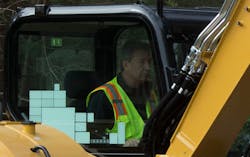How to Use Fault Codes to Improve Operator Performance
Nearly every machine in a fleet, whether new or retrofit with a black box, throws fault codes, and the sheer volume can overwhelm an equipment manager. The number and frequency of email alerts, text alerts, and other communications can easily desensitize the recipient, causing managers to miss data that could help them improve machine performance.
Caterpillar and its dealers have invested in software and personnel to help fleet managers sift through the noise to identify machine data upon which they can actually act.
How to use telematics for operator and driver coaching
“From an aftermarket perspective, we are looking to...turn [machine data] into some sort of information that the customer can make use of to make more money or make his operation safer, more productive, reduce their costs, or control their costs,” says Tim Noon, global quarry technology subject matter expert for construction digital and technology.
Equipment managers can use machine data, specifically fault codes, to benefit fleet performance by using it to coach operators. Operators who correctly use machines maximize productivity and minimize costs. But rather than tackle all areas that indicate a need for operator coaching, Noon says to “focus on a small number of things.”
“Maybe you have two or three faults codes that are your heavy hitters,” he says. “Focus on those and use that as a positive opportunity to engage with your operators and say, ‘We’re seeing a lot of these, can you help me understand why we’re seeing these particular events?’
“When this technology first came out...operators were extremely reluctant to embrace any of it. We’ve seen owners and companies take the initiative and...combat that with a positive experience. That positive experience is key. They [have] the facts to say, ‘It happened three times on Monday and two times on Tuesday, but it didn’t happen at all last week. Can you help me understand? Did something change?’”
A strategy to produce a positive experience in coaching hinges on four key principles, Noon says. Equipment managers seeking to coach behavior change should give the operator a manageable number of areas to address, use facts and data to engage the operator in a positive manner, provide training and coaching based on those areas and the corresponding facts and data, and build coaching into their monitoring process in order to continue that success.
With that strategy in place, Noon says, managers can identify one or two fault codes and coach. If a fault code indicates that an emissions regeneration has been terminated by the operator, for example, “explain to the operator the importance of that.”
“‘I know I’m trying to get you to produce, but this is necessary for the health of the machine and the longevity and the cost of the machine, and our overall company’s success.’ The operator now understands. They’ve built a positive experience.”
Managers can reinforce the behavior change, again supported by data and facts, by offering incentives. Noon says some Caterpillar customers using this coaching strategy offer a reward such as a catered lunch if metrics improve. Acknowledging that performance improvements benefit the company in terms of cost reduction or productivity, these managers use the meal to share the gains.
As with more and more manufacturers, the distribution channel offers the best avenue through which Caterpillar machine data can benefit customers. Local dealers have the relationships and can show their customers how that data can improve operations.
“We see dealers including this telematics data into service contracts or into their PM duties or operator training duties because they know there’s a lot of valuable information in there,” Noon says. “In 2021, customers are probably beyond suffering from information and data overload. Everything is digitally connected and the data is coming from everywhere, but dealers are “step[ing] up: ‘Mr. customer, we’ve noticed that we see something here in your PMs and in these fault codes that could be addressed with some simple training.’ The dealers are taking initiative.”
In addition to their dealers taking a proactive, consultative approach to data, Noon says dealers also offer coaching assistance such as certified dealer instructors and product support experts who have been trained by Caterpillar.
“We have customers who know they have to step into the digital world, they know they have to measure stuff so they can monitor and manage it,” Noon says. “‘I know I have to do it, but I just don’t have the staff.’ Don’t look at it as needing new staff; look at it as having something available to you [from a dealer] to do your job a little better.”
